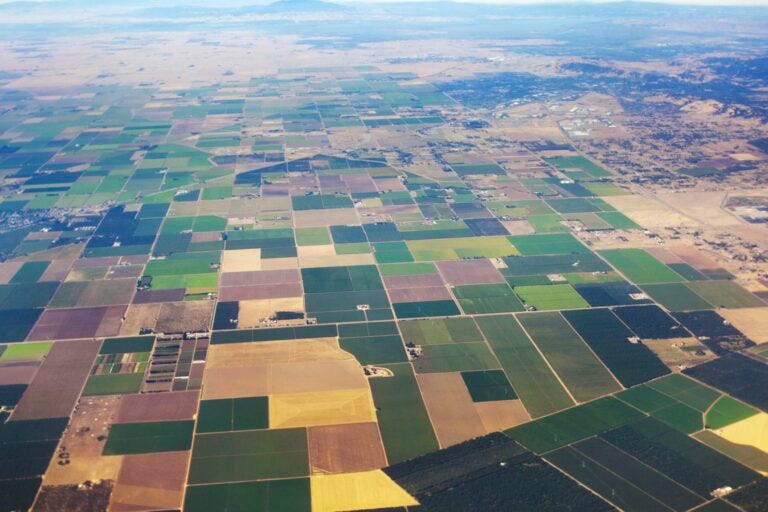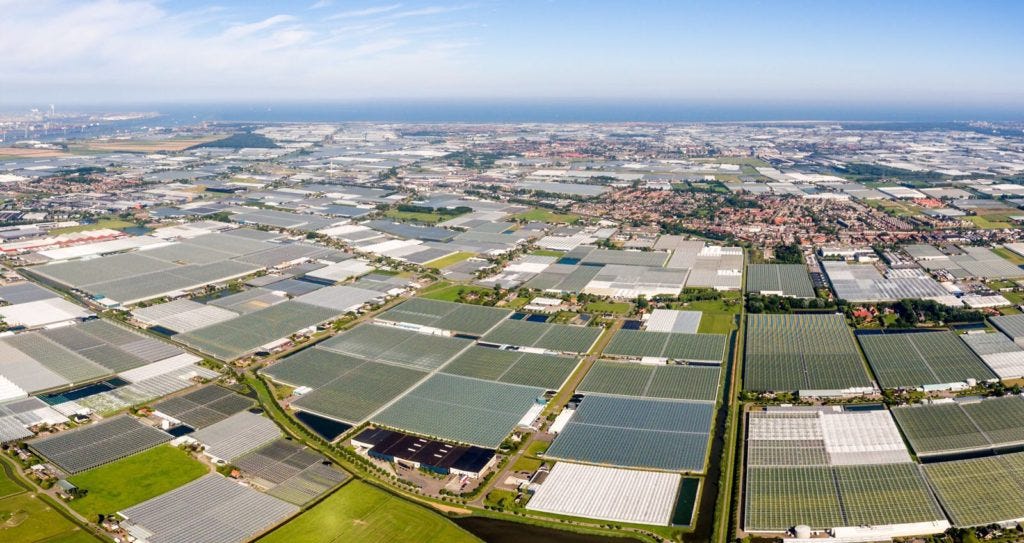We’re all part of the same factory farm
How “feeding the world” has become a marketing scheme for industrialization
My insatiable wanderlust exposed me early to our cultural terraforming of nearly every centimeter of Earth for consumption. We are inching closer to the edge of what can be reduced, simplified, and heaved into commodities - the industrialization of our lives is nearly complete.
The gift of traveling is also a bittersweet reconnaissance: an exploration to discover the unseen and what is taken for granted.
From flying over the San Joaquin Valley and seeing nothing but agricultural fields for miles and miles…
or over Europoort Rotterdam, one of the largest industrial zones in the world…
or over one of Norway’s infamous salmon farms, you get a glimpse of the deepest gears of the industrial machine.
When you begin to see things as they really are in an attempt to understand the meaning behind what we generally conceive of as mundane, it becomes painful to witness industrialization, destroyed landscapes, and cities built from the blood of colonialism.
The march of progress with all of its shiny promises quickly loses its allure and we start to ask questions like is the solution to overfishing really farmed salmon?
Questions like: what happens to the 5 billion farmed fish per year that can’t participate in their bio-appropriate ecosystem?
What happens to the fish that remain wild?
Turns out, the concentration of salmon is a perfect breeding ground for sea lice. As a result, scientists breed the salmon to be resistant to the pest through genetics and vaccinations, but the sea lice have proliferated and have developed a preference for this food source. Now what? Where do they go? To wild salmon.
Salmon farming now rivals overfishing in the destruction of wild fish stocks, meaning that the wild fish stop contributing to their ecosystem because the industrialization of their existence prevents them from nourishing the fjords in the cycle of life.
Salmon are a keystone species. They keep the forest alive. Thwart the lifecycle of the salmon, you thwart the functionality of the entire web of life around it. Artifishal from Patagonia describes it beautifully. Watch the full film to understand the depth of this problem.
Ignore that their feed is shipped over 6,000 miles from soy farms in Brazil using cargo ships (some of which produce more GHGs than 50 million cars, just one pollution and destruction metric of the system). The entire fleet’s emissions would be more than 275 billion cars. With only around 1.5 billion cars in the world, it’s a bit unfathomable, no? But yeah, the individual is the problem. Go buy a Tesla, we’re told.
Add in bilge dumping, which is the process of cargo ships illegally dumping toxic engine waste in the oceans, suffocating marine life on an incomprehensible scale. Visit this active map to see how many of these vessels are in the oceans right now. This video breaks down the problem of bilge dumping, a largely unreported activity:
This isn’t a problem isolated to salmon. It’s proliferated throughout everything in our modern culture.
But when you become disenchanted with the prevailing narrative of progress, you begin to wonder what it was like to be engulfed with it. How did it feel in Westland, Netherlands to watch native pastures disappear and turn into endless whitewalls of greenhouses?
Rather than accepting what is, you start to wonder what was, and what could be.
Like a beaver damming a river, humans consuming what the landscape offers is not inherently a problem. The precarious idea that the living world is ours to control, rather than to be in relationship with, the insatiable growth of the industrial economy, the interconnectedness of our food systems and resource bases have created an illusion of carrying capacity.
We’ve become cogs in the industrialized factory farm.
Most places have more than enough space to fend for themselves, feed themselves, clothe, and house themselves, but GDP and a phantom of growth keep everyone producing and consuming ad infinitum.
It’s easier to buy processed foods from thousands of miles away than it is to buy foods native to an area or culture. Why?
We’ve bought into a globalized food system and the perception that it’s every country’s responsibility to “feed the world” as a way to masquerade good intentions while growing markets. Good intentions justify the destruction of the fjords. Good intentions justify endless greenhouses in what used to be biodiverse prairies. Good intentions turn England’s and America’s grasslands into wheat and corn fields.
“Good intentions” rooted in industrialization justify turning the world into a factory farm.
Yet we rarely ask if it’s working. Do Norwegian salmon or regeneratively-raised Texan livestock need to feed the world or can people eat the most nutrient-dense, culturally appropriate foods their landscapes can sustainably provide them? Does the world need to eat greenhouse-grown tomatoes from Holland or can folks grow them when they can on their porch? Does Mexico need to feed the world, or can Mexico feed itself?
If we don’t question the assumption that we need to “feed the world” we also won’t ask other questions. Why is it “unsustainable” and “releasing too much carbon” for some countries to burn trees for cooking and warming their homes, but when other countries import their trees to burn in biomass facilities, it’s “renewable energy”?
We can’t let the smokescreen of the energy crisis and climate change be used to exploit land, water, biodiversity, agriculture…and life.
We can’t let the notion of “feeding the world” hinder us from regenerating the local ecosystems, communities, and health of our regional locale.
Our best foot forward is to acknowledge that each path is different for everyone and take responsibility for our existence and our role in ecology. This will require a level of innovation to reconnect us with our landscapes, like those we are working to support at Grassroots Carbon.
Reconnection and regeneration will look different for everyone, a unique nuance that’s rarely tolerated in industrialization, but if we’re to stop factory farming - of our food, our planet, and ourselves - we have to break free.
"If there are still people here in 200 years, they won’t be living the way we do. I can make that prediction with confidence because if people go on living the way we do, there won’t be any people here in 200 years." - Daniel Quinn, The Invisibility of Success
Disclaimer: The Regeneration Weekly receives no compensation or kickbacks for brand features - we are simply showcasing great new regenerative products.
If you have any products you would like to see featured, please respond to this newsletter or send an email to meg(at)soil.works
The Regeneration is brought to you by Grassroots Carbon, a regenerative carbon credit provider incentivizing grassland regeneration at scale. Are you a rancher interested in being paid to sequester carbon? Learn more here. Are you interested in buying carbon credits that support regeneration and impacts beyond carbon? Learn more here.






